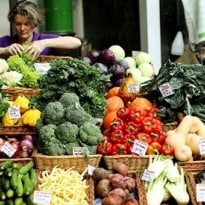The volatile compounds that make strawberries so delicious could one day make bitter vegetables a little more palatable
For many Britons, forcing down the recommended five daily portions of fruit and veg already presents a challenge. Then on Tuesday came the news that even five may not be enough - seven portions are a better target to prevent heart disease, strokes and cancer.
Worse, we are now told that most of those seven should ideally be vegetables. Many children have a particular dislike of vegetables, and simply yelling "eat your greens" is unlikely to change that. The answer may be to make vegetables taste better for those among us who are especially sensitive to bitter flavours.
In the town of Gainesville in northern Florida, a group of scientists has spent the past five years investigating the taste secrets of freshly grown strawberries. What they have discovered may provide pointers that will help us manipulate flavour to trick ourselves into liking healthy foods.
The flavour of food is a complex simulation created by our brains that draws on the full range of our sensory spectrum. When you bite into a strawberry, the initial reaction comes from your taste buds, embedded in the many spongy papillae that cover the surface of your tongue. They detect the five basic flavours - sweet, salty, bitter, sour and umami (or savoury). This is only a small component of flavour, however, merely enabling you to sense that the fruit is sweet, for example. An extra layer is added by "trigeminal sensations" that allow you to experience the cool of fresh watermelon or the tingling of hot peppers.
But what most of us think of as taste is actually smell, and without this sense our experiences of food would be almost uniformly bland. Biting into the strawberry releases volatile chemicals that travel up through the back of your mouth into your nose, and are more responsible than anything else for creating the impression of flavour.
Each of us experiences the flavour of the same food in our own unique way. There is a huge variability in sensitivity to the same foods and for many years, scientists have been trying to understand why, for example, some of us crave hot and spicy flavours while others actively avoid them.
We now know that taste preferences are partly determined by our genetic make-up, but our likes and dislikes are also heavily influenced by eating experiences when we're very young. In particular, this affects our pre-programmed aversion to anything bitter.
Kathleen Keller, a food scientist at the University of Pennsylvania, has been trying to understand the very earliest part of this process. All children have a natural preference for sweet foods but there's a huge amount of variability, with some proving far more willing to try bitter-tasting vegetables such as sprouts and spinach than others.
Children are especially sensitive to a bitter-tasting synthetic compound known as PROP, but Keller has discovered that the extent to which we can taste it is determined by our genes. For example there's a gene that produces a receptor protein called TAS2R38, says Keller, part of a family of bitter taste receptors. "We have about 25 of them and they bind to bitter compounds and send information to our brain about what a particular compound is. Depending on the variant of the gene that you have, you're going to be more likely to taste PROP far more strongly."
Our taste preferences do not remain static throughout our lifetime. Many of us find that we come to relish foods that we once hated. As we age we lose taste cells, making us less sensitive to bitter flavours. However, there are some dislikes that have become so deep-rooted in childhood, we never overcome them.
Because our idea of flavour is constructed in our brain, it also draws on emotions and most importantly, memory. Childhood memories are often the most intense and a really bad experience with a particular food can come into play years later, as your body's way of protecting itself against food that has made us sick in the past.
Food manufacturers have traditionally sought to overcome the huge variability in taste preferences by masking flavours we may dislike with copious amounts of added sugar, artificial sweeteners, fat and salt, but one day we may be able to exploit our understanding of flavour to trick the brain into making things appear sweeter or saltier than they actually are.
The team in Florida has identified 31 different compounds that constitute the taste of a strawberry. They now want to explore whether it's possible to introduce these compounds into vegetables to make them sweeter and more desirable.
"In the near future we might well have different types of foods that are specifically geared for people who have a very strong sensitivity to bitter," says Keller. "This is important as there's a high correlation between the ability to taste PROP and liking foods with a high fat and sugar content."
"One of the other applications that we're interested in is whether there might be different types of diets someone would be more likely to stick to because of their genes. Modelling someone's nutritional intake on their genetically informed food preferences could be a better way to get people to actually comply with a healthier, more balanced diet."
Of all our senses, taste is the one we associate most with pleasure, and as such we're continually torn between our desire to be healthy and our basic human urge to consume what we enjoy, in the quantities that we want. It may prove impossible to curb this basic drive, but through improving our understanding of how flavour works, we may develop a means to work with it.
Photo: Many of the healthiest vegetables are bitter-tasting, which is a problem for those of us whose taste buds are highly attuned to these flavours. Photograph: Graeme Robertson/Guardian







